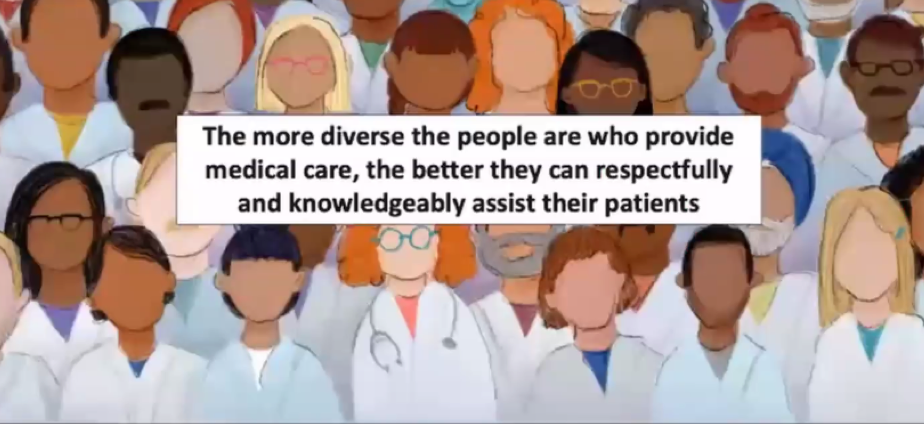She began by defining diversity and inclusion. She conceptualized diversity as the “who” and “what”, captured by characteristics including race, gender, sexual orientation, among many others. In contrast to the “nouns” characterizing diversity, inclusion is an action (the “verb”). Thus, inclusion is the behaviours that embrace and include others.
Dr. Smith then highlighted many metaphors for diversity and inclusion, each of which highlight the differing but related nature of these. Alluding to the title of her talk, she utilized the metaphor of “the dance” – while diversity represents being invited to the part, inclusion is actively being engaged, being asked to dance. To truly engage, both are required. She then considered the seed metaphor – highlighting that a seed’s potential for growth and development is only reached when it has an environment which facilitates this. Finally, she cited the parable of the five blind men and the elephant – each man, in describing a different part of the elephant provides a different description of it. They all disagree though are individually correct. It is only by working together and acknowledging the unique but incomplete perspective that they each bring that they are able to understand what it is that they are touching.
Dr. Smith then emphasized why diversity and inclusion matters. On a very personal level, diversity adds depth and texture to our lives and our perspectives – while we are rarely challenged when we consider only a single perspective, this is a stagnant course with little potential for growth.
From a systems perspective, there is considerable evidence that diversity increases the creativity and problem-solving abilities of teams. She highlighted the example of the Netflix Prize which took collaborating teams embracing outlier approaches to achieve.
In the context of medical care, Dr. Smith emphasizes that the more diverse the workforce providing medical care, the better we can respectfully and knowledgeably address the issues that are important to our patients.

Further, patients often prefer physicians who share their characteristics, whether that be gender, race, or others. Highlighting her own example, Dr. Smith highlighted that as a female urologic oncologist, she has patients travel significant distances to see her given the comfort they feel with her. Thus, diversity in health care improves processes for providing care through interactions between doctors and our patients.
The value of diversity extends to research in which broad perspectives enrich and broad the questions we ask and the answers we seek.
To achieve diversity in institutions, we must embrace diversity in leadership allows for innovation, new and fresh perspectives. Unfortunately, as a field, we have a long way to go in urology – with a dramatic underrepresentation of visible minorities in Urology that worsen as seniority rises.
There are many efforts underway to address this, including, from the American Urologic Association, a recently conceived Diversity and Inclusion Task Force, led by Dr. Tracey Downs.
Given what we know about their importance, Dr. Smith then confronted the question of why it is so difficult to promote diversity and inclusion. She acknowledged that, even after much contemplation, she doesn’t have the answer to this complex issue. However, she suggested that implicit bias may contribute. This however may be an overly naïve answer, given the importance of structural racism. Structural racism and implicit bias are, however, inter-related in Dr. Smith’s view with structural racism within our schemas of the world fomenting implicit bias.
One of the first ways to address implicit bias is to acknowledge and understand it. Dr. Smith highlighted examples of a number of different tests that may be used to test for implicit bias. Using her own test results as a guide, she emphasized the importance of understanding our implicit biases so that we may, at a minimum, acknowledge them and be cognizant of how they affect the way in which we view the world.
Considering how we may address barriers to diversity and inclusion, she suggested a number of approaches:
1. to think outside the box, on the rationale that “inside the box thinking” is driving by our implicit biases.
2. to think at every level, considering the diversity of all members of the team. Citing a clinical example, considering everyone from the front desk to institutional leadership.
3. to keep hiring committees diverse, as our implicit biases will always draw us to choose people like ourselves. Thus, a homogenous hiring committee is likely to perpetuate these characteristics.
4. to truly include diverse staff, avoiding tokenism and recognizing and empowering them to take on role and responsibilities within their abilities and interests.
5. to check up on progress, to ensure that progress is being made.
6. to get involved. To this end, she cited a number of groups including the Urologists for Equity (https://twitter.com/uroforequity?lang=en).
Moving forward, Dr. Smith suggested that, both individually and as institutions, we need to set measurable goals to which we can hold ourselves and others accountable.
Presented by: Angela Smith, MD, MS, Vice Chair Of Academic Affairs, Director Of Urologic Oncology Associate Professor Of Urology, University of North Carolina School of Medicine
Written by: Christopher J.D. Wallis, Urologic Oncology Fellow, Vanderbilt University Medical Center, @WallisCJD on Twitter during the 85th Annual Southeastern Section of the American Urological Association, April 23-24, 2021

